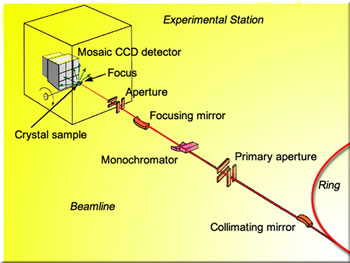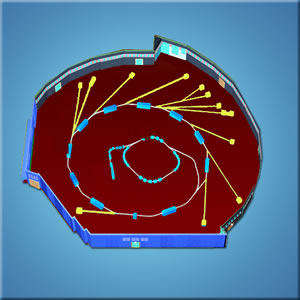| The beamlines Kimberly Reetz wants to
know about are the business ends of the Advanced Light Source, the straight
tubes or pipes that conduct energetic light outward from the big synchrotron
storage ring under the ALS dome to a variety of experimental devices on
the surrounding floor.
|
|

|
 |
|
|
The experimental station and some
internal optics are indicated in this sketch of a beamline designed
for molecular biology.
|
|
|
|
Most ALS beamlines carry extreme ultraviolet light (EUV) or "soft"
x-rays — that's the energy range the ALS was originally designed
for — but special magnets have been installed in the ring to produce
more energetic "hard" x-rays as well. One set of beamlines even
carries visible light and low-energy, infrared radiation. Inside a beamline
the light may be reflected, refracted, focused, filtered, and chopped
up. Most of it is invisible, but it's all light, and much brighter than
the sun.
Grouped with each beamline is the experimental devices it is designed
to serve. Some produce highly magnified microscopic images of living cells;
some create diffraction patterns of crystallized proteins to determine
their structure; others shine x-rays on semiconductors to free electrons
and examine magnetic properties; still others measure the surfaces of
mirrors to an accuracy of better than a billionth of a meter. The 40 beamlines
currently operational (more are on the way) have been put to a myriad
of uses in chemistry, biology, the environment, materials sciences, geology,
archaeology, and other fields.
A glance at the way the ALS is laid out shows that the beamlines radiate
from the circular synchrotron storage ring at a tangent, like spokes from
the hub of a bicycle wheel. This is because the light that goes down each
beamline pipe is given off straight ahead when speeding electrons in the
storage ring are forced to turn around the ring. Picture the headlight
on the locomotive of a toy electric train going around on a circular track;
beamlines are like soda straws down which the headlight beam shines, one
after the other.
|
|
 |
 |
|
|
|
In this sketch of the Advanced Light
Source, a few representative beamlines are pictured in yellow. |
|
|
How is the light created? Any time an electron or other charged particle
changes speed or direction it sheds energy in the form of photons, particles
of light. (It's the electrons jiggling in a hot filament that make an
ordinary incandescent light bulb shine.) When synchrotrons were first
built for high-energy particle physics in the 1940s, this lost energy
was considered wasted. Not until the early 1960s was synchrotron radiation
appreciated for its own sake, as a source of light beams that are bright,
energetic, and highly collimated (that is, with all their photons traveling
in parallel).
A beamline is what conveys this extraordinary light to the place where
scientists can use it to explore the universe of materials, chemical reactions,
and living things.
Additional information
Is there something you've been wondering about? Contact wonder@lbl.gov. |

